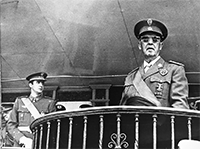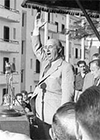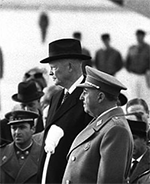Francisco Franco: Spanish General, Dictator
Part 3: The Dictatorship
In addition to staying out of the fighting, Spain removed itself from the international economy during the war. As a result, the Marshall Plan—a very large aid package extended by the United A series of constitutions in the 19th and early 20th Centuries had given Spanish people varying amounts of individual and collective rights and privileges. The people living under Franco's rule had certainly less of those. Political dissent was strongly discouraged, trade unions were outlawed, and even cultural diversity was repressed. The official language was Castilian Spanish, which was used in government documents, in schools, in advertising, and on road signs; the use of other Spanish languages was legally forbidden for many years. Enforcing all of this law and order was the Guardia Civil, a form of military police. The state-sanctioned Catholic Church forbade divorce and made itself the arbiter of all marriages, even those performed by members of other faiths before Franco took over. As well, anyone who wanted to serve in government had to be a Catholic. The list of Spanish colonies shrank under Franco's rule. After France lost its share of Morocco in 1956, Spain followed suit. As well, Equatorial Guinea, which had been Spanish Guinea since 1778 and the days of the Viceroyalty of the Rio de la Plata, became independent of Spanish rule in 1968. 
Franco had a daughter but no son. He wanted a man to succeed him and so, in 1969, chose as his successor Juan Carlos de Borbón, the grandson of Spain's previous king, Alfonso XIII. The king's own son, Don Juan, was still living, but Franco didn't want him to rule the country. Franco avoided the daily running of the country more and more as he aged. He enjoyed fishing and hunting and spent much time doing both. In his absence (but likely with his acquiescence), the government relaxed restrictions on protests and speech, both spoken and written. In 1973, Franco appointed Luis Carrero Blanco as prime minister, a position that Franco had previously held for himself. Carrero Blanco died in an explosion a few months into his term; his successor was Carlos Arias Navarro. Juan Carlos took over as head of state when Franco became ill, on July 19, 1974. El Caudillo recovered and ruled for another year, during which he battled a number of illnesses, including Parkinson's disease. He died on Nov. 20, 1975, after a month in a coma. The new King of Spain was Juan Carlos I. First page > Meteoric Rise > Page 1, 2, 3 |
|
Social Studies for Kids
copyright 2002–2026
David White



 After the war, Franco continued to rule Spain as a dictator. One of his most common appellations was El Caudillo (The Leader). He did establish a parliament equivalent, the Cortes Españolas, on July 17, 1942, to mark the fifth anniversary of the beginning of the Civil War. The Cortes did have a president, and Franco did have ministers who reported to him and nominally advised him. However, he was the government, its policies coming in the form of decrees from El Caudillo. Similarly, Franco announced in 1947 the establishment of a monarchy but did not name the monarch; instead, he named himself regent for life.
After the war, Franco continued to rule Spain as a dictator. One of his most common appellations was El Caudillo (The Leader). He did establish a parliament equivalent, the Cortes Españolas, on July 17, 1942, to mark the fifth anniversary of the beginning of the Civil War. The Cortes did have a president, and Franco did have ministers who reported to him and nominally advised him. However, he was the government, its policies coming in the form of decrees from El Caudillo. Similarly, Franco announced in 1947 the establishment of a monarchy but did not name the monarch; instead, he named himself regent for life. States to most other countries in Europe to help rebuild—did not include Spain. Relations with the U.S. thawed in 1953, however, when then-President
States to most other countries in Europe to help rebuild—did not include Spain. Relations with the U.S. thawed in 1953, however, when then-President 
